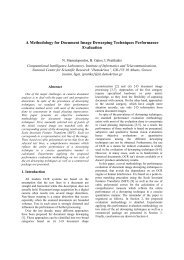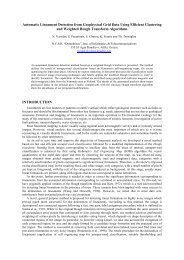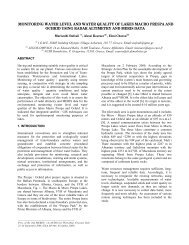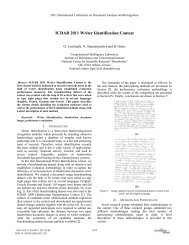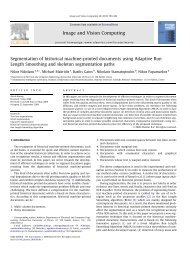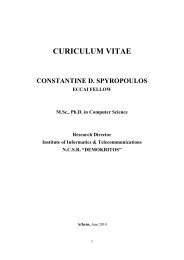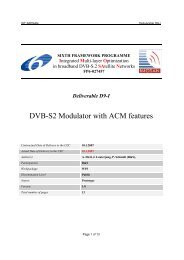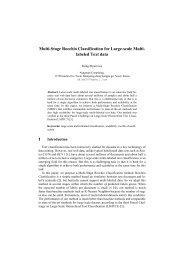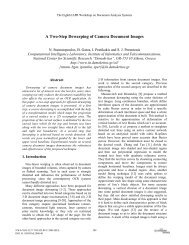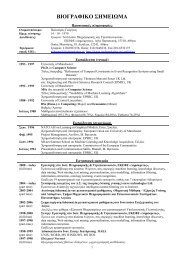TMS320C6713B Floating-Point Digital Signal Processor (Rev. A)
TMS320C6713B Floating-Point Digital Signal Processor (Rev. A)
TMS320C6713B Floating-Point Digital Signal Processor (Rev. A)
You also want an ePaper? Increase the reach of your titles
YUMPU automatically turns print PDFs into web optimized ePapers that Google loves.
SPRS294A − OCTOBER 2005 − REVISED NOVEMBER 2005<br />
bootmode<br />
reset<br />
The device resets using the active-low signal RESET and the internal reset signal. While RESET is low, the<br />
internal reset is also asserted and the device is held in reset and is initialized to the prescribed reset state. Refer<br />
to reset timing for reset timing characteristics and states of device pins during reset. The release of the internal<br />
reset signal (see the Reset Phase 3 discussion in the Reset Timing section of this data sheet) starts the<br />
processor running with the prescribed device configuration and boot mode.<br />
The C6713B has three types of boot modes:<br />
Host boot<br />
If host boot is selected, upon release of internal reset, the CPU is internally “stalled” while the remainder of<br />
the device is released. During this period, an external host can initialize the CPU’s memory space as<br />
necessary through the host interface, including internal configuration registers, such as those that control<br />
the EMIF or other peripherals. Once the host is finished with all necessary initialization, it must set the<br />
DSPINT bit in the HPIC register to complete the boot process. This transition causes the boot configuration<br />
logic to bring the CPU out of the “stalled” state. The CPU then begins execution from address 0. The DSPINT<br />
condition is not latched by the CPU, because it occurs while the CPU is still internally “stalled”. Also, DSPINT<br />
brings the CPU out of the “stalled” state only if the host boot process is selected. All memory may be written<br />
to and read by the host. This allows for the host to verify what it sends to the DSP if required. After the CPU is<br />
out of the “stalled” state , the CPU needs to clear the DSPINT, otherwise, no more DSPINTs can be received.<br />
<br />
<br />
Emulation boot<br />
Emulation boot mode is a variation of host boot. In this mode, it is not necessary for a host to load code or to<br />
set DSPINT to release the CPU from the “stalled” state. Instead, the emulator will set DSPINT if it has not<br />
been previously set so that the CPU can begin executing code from address 0. Prior to beginning execution,<br />
the emulator sets a breakpoint at address 0. This prevents the execution of invalid code by halting the CPU<br />
prior to executing the first instruction. Emulation boot is a good tool in the debug phase of development.<br />
EMIF boot (using default ROM timings)<br />
Upon the release of internal reset, the 1K-Byte ROM code located in the beginning of CE1 is copied to<br />
address 0 by the EDMA using the default ROM timings, while the CPU is internally “stalled”. The data should<br />
be stored in the endian format that the system is using. The boot process also lets you choose the width of<br />
the ROM. In this case, the EMIF automatically assembles consecutive 8-bit bytes or 16-bit half-words to<br />
form the 32-bit instruction words to be copied. The transfer is automatically done by the EDMA as a<br />
single-frame block transfer from the ROM to address 0. After completion of the block transfer, the CPU is<br />
released from the “stalled” state and start running from address 0.<br />
A hardware reset (RESET) is required to place the DSP into a known good state out of power−up. The RESET<br />
signal can be asserted (pulled low) prior to ramping the core and I/O voltages or after the core and I/O voltages<br />
have reached their proper operating conditions. As a best practice, reset should be held low during power−up.<br />
Prior to deasserting RESET (low−to−high transition), the core and I/O voltages should be at their proper<br />
operating conditions and CLKIN should also be running at the correct frequency.<br />
98 POST OFFICE BOX 1443 • HOUSTON, TEXAS 77251−1443



